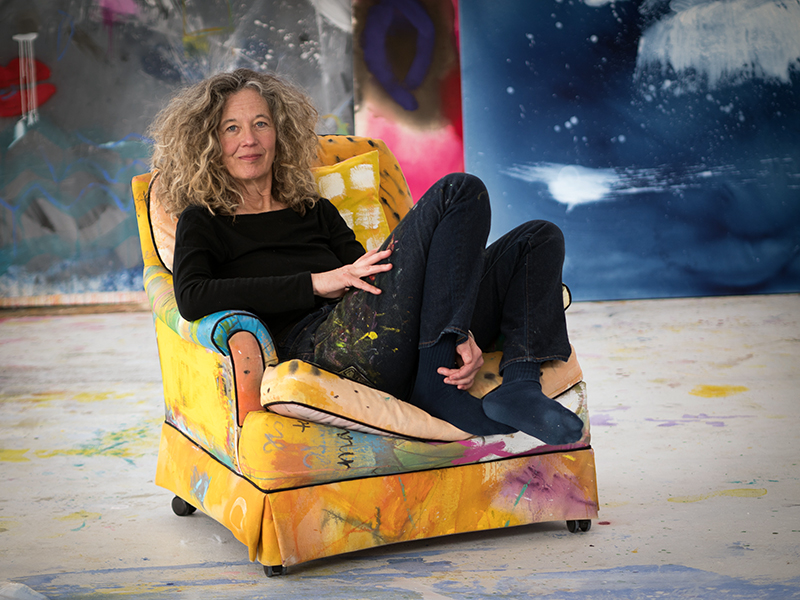Presented by Equity Bank

One of the first things newcomers notice when they debark at the Kansas City airport is the big sky. It suggests a life of possibilities and infinite change.
Such has been the case for abstract artist Jane Booth, who watches the sky and the prairie landscape and paints monumental canvases that capture the ever-changing spirit of the place where we are lucky enough to live.
Years ago, Booth gave up a corporate career, focused on her art, and eventually moved to a ranch in Spring Hill, Kansas. Says Booth, “Wide-open spaces are essential for me to find peace and ease as a human being. The studio sits high enough on a ridge to see storms building from miles away.”
Booth has other influences, too. “While the natural world is the ground of my work, I also draw from literature, poetry, music, and other’s art on view in galleries and art museums,” she says. “Right now, I’m studying mythology and the ecstatic poetry of the Kabir, Proust’s Remembrance of Things Past (in English) and Joan Miro’s autobiography.”
Jane Booth’s work is featured in galleries in Kansas City and across the country.
To learn more about Jane Booth, visit janebooth.com.
How does the open prairie around your ranch help inform/inspire your work?
My attention focuses on the wind and rain, sunlight and fog, grasses and forbs, raptors and stars. Yesterday as I was walking down the hill, I heard the soft keening of migrating snow geese high overhead. The open, gray skies dotted with their tiny, organized forms were achingly beautiful, piercing my being. These experiences are revealed in my work.
How does a girl who once studied French at the Sorbonne maintain that je ne sais quoi?
My love of France comes from my mother, who lived in Paris as a young woman, and infused our family’s lives with all things French. Boeuf bourguignon is the centerpiece on Christmas Eve, and Le Fou Frog is our favorite for special occasions.
I love the common French greeting “Je suis enchante de faire votre connaissance” (I’m delighted to make your acquaintance). Through their language, beauty and elegance are woven into their everyday lives. As to swearing in French, it’s entirely unsatisfying for its lack of consonants.
Tell us about how you paint—how you suggest the primordial, the temporary, the slow drift of life?
I begin by spreading raw, unstretched canvas on the ground. Drawing my senses to the forefront, thinned pigments are poured and pushed into the canvas, creating veils of color, which become the vast space in which the painting lives. This is a very quiet part of the process, an act of listening rather than speaking.
The canvas is then pinned to the wall where a kind of dialogue begins, one mark calling for another, recorded with brushes, gloved hands, graphite, acrylic paint, spray paint, pencils and crayons. These marks and gestures are responses to sensory and intellectual experiences.
How has your artistic career evolved? Where do you want to be?
Painting came as a surprise years after graduating from college where I’d focused mostly on ceramics and drawing. I’d stayed alive by working as a welder, which morphed into a corporate career, and kept my artwork alive through life-drawing classes.
Years later while on sabbatical, I stumbled into Philomene Bennett’s studio classes in the West Bottoms. I began to work incessantly and with conviction, and in a leap of faith, I gave notice at my paying job, and began to paint wherever I could find the space to roll out large canvases—sometimes the living room floor, a basketball court, a sleeping porch, eventually settling into a studio set up in a large, unused bedroom.
I was lucky that the work I loved to do was selling.
In 2014, I built a very large, light-filled studio. Having that dedicated space where I could spread out and pin up massive bodies of work to analyze and adjust gave me confidence to push past comfort zones and into a rich discovery mode, which is where an artist really grows. It also allowed the paintings to become larger. The studio’s inaugural painting was a commission for a resort in Costa Rica that measured 27 feet long.
Working with excellent galleries allows me to dedicate my time to the visual world.
I’m very grateful to be right where I am today.

